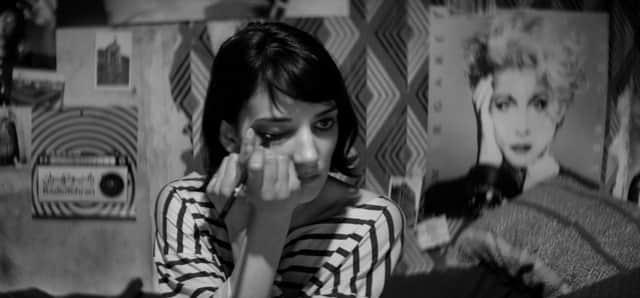Film review: A Girl Walks Home Alone at Night


A Girl Walks Home Alone at Night (15)
Directed by: Ana Lily Amirpour
Starring: Sheila Vand, Arash Marandi, Dominic Rains * * *
Sure, the titular blood-sucker’s wearing of a chador could be read as a literal veiled comment on the way Muslim women are sometimes forced into the shadows by religious and societal conventions, but any politicised feminist slant in Ana Lily Amirpour’s debut is subsumed by its status as a self-conscious exercise in filmmaking style.
Nothing wrong with that, per se, especially since this plays out like a deliberate act of cinematic vampirism. Feeding off Jim Jarmusch’s body of work, it transfuses the same jazzy influences to arrive at a hipster cinematic universe in which all inhabitants seem forever cursed to exist in a quotation-marked state of cause-shirking rebellion more redolent of the 1950s. Shot in monochrome and set in a fictitious Iranian ghost town named Bad City, the film’s Farsi-speaking cast seem like echoes of those ne’er-do-wells from Jarmusch efforts such as Down By Law and Stranger Than Paradise.
Advertisement
Hide AdArash (Arash Marandi) is the son of an ageing junkie whose habit is attracting the wrong sort of attention. Amirpour initially keeps the story focused on Arash and his father’s dealer, Saeed (Dominic Rains). But when Saeed picks up a woman one night and gets more than he bargained for from her sharpened incisors, the film shifts its focus to this mysterious woman with a taste for blood.
Played by Sheila Vand (above), ‘the Girl’ – we never learn her real name – skulks though Bad City’s nocturnal streets on a skateboard, dispensing gory justice to exploiters of women (and cats). But as she finds herself drawn to Arash after meeting him on his return from a Halloween party, it soon becomes apparent that she’s craving more than the blood of the damned. These kinds of developments can come across as a little cute, particularly as the film expects us to intuit the shape of the subsequent narrative from artful compositions arranged in oblique and patience-testing ways.
The film’s abundance of style rings hollow at times, but a few transcendent moments make up for it. We’re told next to nothing about ‘the Girl’, for instance, yet her bedroom – decked out in posters of pop stars and lit by the glow of a glitter ball – is as eerily suggestive as the irrepressible yearning of her blackened heart of an adolescence brought to an abrupt end.